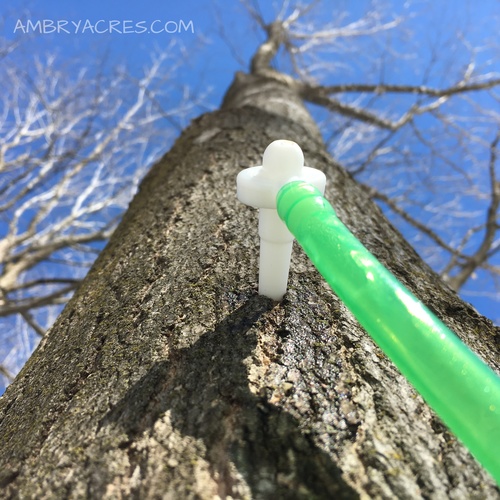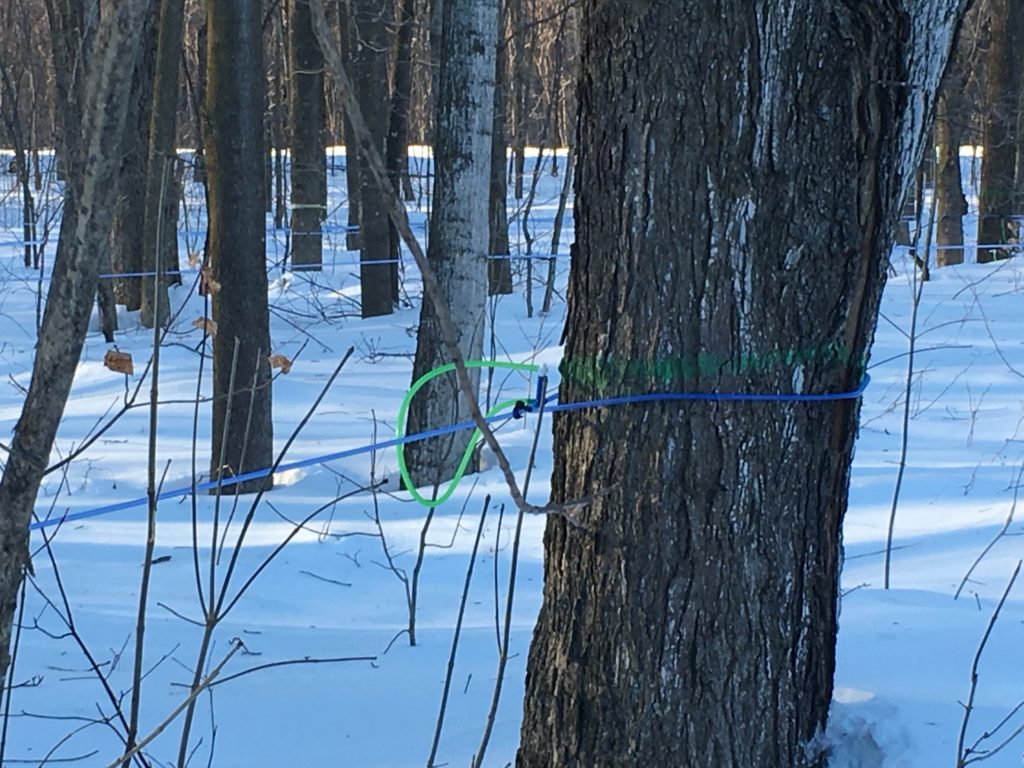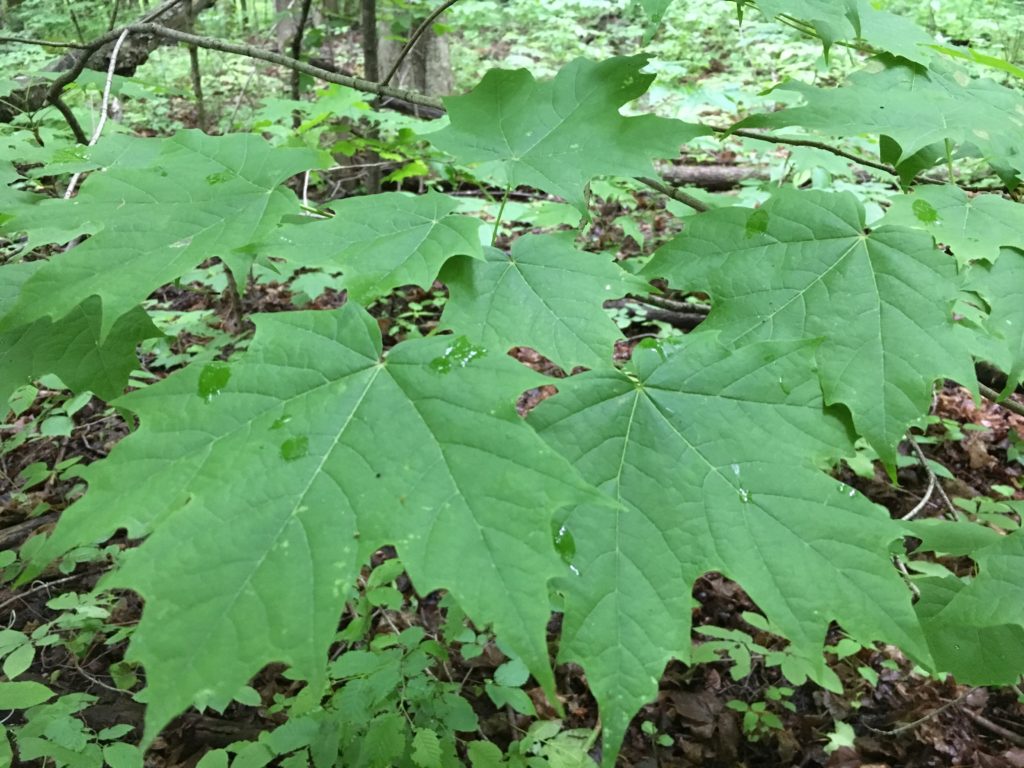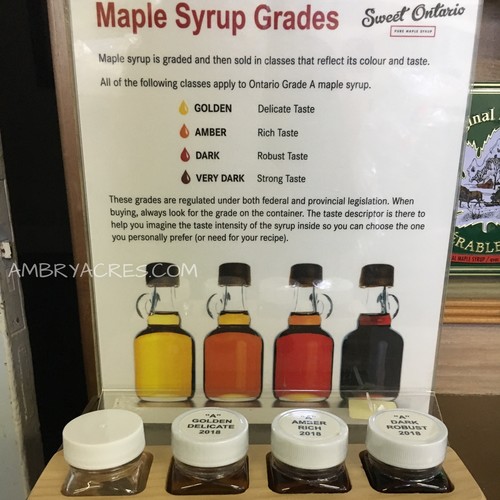Maple Syrup is made by collecting the sap from the Acer saccharum (Maple Tree). This occurs when the tree sap begins to flow naturally. As the temperatures begin to fluctuate and early spring weather begins, the sap flows through the tree.
First, a tiny hole is drilled into the tree. Second, we gently tap a spout into the hole which allows us to connect pipeline tubing. The sprout catches the trickling sap when the weather is just right. At this time it flows through the pipeline which is then stored in a large stainless steel insulated bulk tank.
Once we have enough sap collected we then pump the sap out of the holding tank into a secondary sap tank located inside our sugar shack. We take a reading of the sap at this time and record the sugar content using a sap hydrometer.
Pipeline Tubing in place awaiting necessary fluctuations in temperature before tapping trees takes place. Therefore, they are connected to trees only throughout the 4 to 6 week season.
Finally, when we’re ready to begin the process of boiling to make maple syrup we get the sap to flow into a wood burning evaporator. It’s boiled until most of the water has been evaporated, and it is concentrated to syrup. Often the temperature at which sap becomes syrup is 7.1 degrees Fahrenheit above the boiling point of water which may change throughout the course of the day based on weather patterns and atmospheric pressure.
Sap Collecting
In January, we need to be ready to collect the sap if the temperatures are ideal. The first step taken is drilling a hole for the tap.
This step occurs within a few weeks of the start of the season.
When to Tap
The winter season tends to alter each year making it impossible to schedule the exact start and end dates for making maple syrup in Canada. Without a doubt, the season is dictated by the weather; and the rule of thumb is that it begins with a change in temperature of +5 degrees Fahrenheit during the daytime with -5 degrees Fahrenheit during the night. The trees are basically frozen and it takes an extended period of warm temperatures to start the sap flow. A pattern of freezing and thawing temperatures will build up pressure within the trees causing the sap to flow from the tap holes.
Typical Season
We typically start tapping in February when the five-day forecast calls for warm days above freezing.
The sap sugar content starts out low, builds throughout the course of the season, and then drops off toward the end.
Season runs typically four to six weeks.
Tree Management
We have chosen to manage our forests and this decision involves many steps, decisions and knowledge. In addition, every Maple Tree in our bush has been identified and measured to provide us with the information needed to manage our bush for sustainability and growth. We tap our trees following recommended best practices set out by OMSPA and work closely with a Senior Forestry Technician every step of the way.
How to Tap
Finding the Right Spot
The first step in tapping is finding a good spot to drill the hole. To get a decent amount of high-quality sap, drill into clear, white sapwood. It is important to avoid previous tap holes and the associated stain columns as well as other defects and rotten areas on the trunk. Large seams and wounds are easy to identify and avoid, but it takes knowledge and experience to locate old tap holes. We stay at least 1” to the left and right and 12” up and down on the trunk from an old tap hole.
Drilling the Hole
It is essential that you have good footing and proper control of the drill to make sure your hole is perfectly round. Some people advocate drilling the hole directly into the tree whereas others recommend drilling at a slight upward angle. Try to achieve a perfectly straight hole but always err on the side of making it at a slight upward angle whenever necessary. Absolutely be sure to use a new, clean, sharp drill bit that is intended for drilling into maple trees. Rusty and dirty drill bits immediately contaminate tap holes, be sure to properly maintain your drill bits between seasons or purchase new ones every year. Drill in 1.5” – 1.75” deep.
Setting the Spout
This is the final step to tapping the tree. Use a regular hammer to set the spouts. It just takes a few gentle taps.
When it is Syrup?
Last but not least, the sap flows into a wood burning evaporator and is controlled by using a float to maintain adequate levels of sap inside the evaporator.
It is syrup when the sugar content reaches 66 %. To determine the sugar content of the syrup, we need to use another tool, called a refractometer, to take the reading.
Steps Involved
Often the temperature at which sap becomes syrup is 7.1 degrees Fahrenheit above the boiling point of water which is around 219 degrees. We constantly check the syrup with a refractometer to make sure we draw-off at the right temperature. When the thermometer in the pan reaches 219 degrees the syrup is ready to draw off. Even though it looks like the finished product it will still need to be filtered, adjusted for density and graded for flavor and color and bottled.
Quick Visual Test
We like to perform an apron test to ensure we produce thick syrup. As the sugar increases through the boiling step, the syrup thickens so it sheets off the edge of a metal scoop
Filtering Syrup
In the process of making syrup, some of the minerals precipitate out as niter on the syrup pans while some remain suspended in the syrup and make it appear cloudy. Unquestionably, it needs to be filtered before it is bottled. Apart from this; it’s to be done while it’s extremely hot.
Furthermore, Gravity Filtering is used with our operation because we are small-scale sugar makers. This process uses a cone filter with 5 paper filters sitting inside a felt liner and we let gravity do the work. This does a pretty good job, but the process is slow.
Bottling Syrup
Once we have finished producing and filtering our maple syrup, it is ready for bottling. Importantly, to kill off any bacteria, yeast or mold, it must be heated to 180 degrees F or 190 degrees F if packaging in glass.
Double check the density of the syrup and adjust as necessary. The legal minimum is 66 percent sugar content but bottling syrup at 67% is recommended. The extra 1% sugar content makes the syrup feel a lot thicker and is much more enjoyable to consume.
Fill the bottles to the bottom of the neck with syrup, screw the cap on properly and then set them on their side. By doing, it provides an induction seal on the cap while allowing us to check that the cap is on properly without any leakage.
Keep Detailing Records
Keep detailed records on production batches including containers sizes and quantities. For this reason; we clearly label all bottles with the specific batch codes and keep detailed records of what bottle types and sizes were used and how many of different sized containers were filled.
Grading Syrup
All grades of pure maple syrup are identical in density and maple sugar content, the color of the syrup ranges from pale golden to dark brown. Since color is objective and is easily distinguished with light transmittance meters, all the grading systems focus on the color of the syrup. Color is a good indicator of the intensity of the flavour.
All grades of maple syrup are produced using the same methods. Difference in color is a result of when the syrup is made based on the beginning of the season versus the end of the season.
Changes in Color
As the spring season comes to an end, the sap coming from the trees becomes darker in color and the sap sugar content decreases which produces darker syrup because the lower the sugar content of the sap, the longer the boiling time required. Corresponding to color, the darker the syrup is, the stronger its flavor. The Ontario Maple Syrup Regulations distinguishes four maple syrup grades being Golden, Amber, Dark and Very Dark.
Maple Syrup Season Finishes
As soon as the leaf buds begin to open up, the Sugaring season ends.
Season Wrap Up
The next steps are to pull the taps & clean the equipment. Not to mention, enjoy maple products which are often enjoyed by family and friends and sold through our farm gate sales, locally at health and all-natural foods stores like Sharon’s Pantry and online here.
All spouts are pulled immediately after the sugaring season to give the trees maximum time to heal over tap holes.
Storing Maple Syrup
After a successful season, we need to store our products . According to Massachusetts Maple Producers Association , unopened, maple syrup will keep indefinitely. As a result of this being an all-natural product with no preservatives; once opened; it’s ideally refrigerated or freezer.
Fuel for our evaporator
Our evaporator burns wood for making maple syrup. Consequently this requires preparation and storage of wood. We recycle pallets and build into wood storage boxes. However, we still need to keep the wood dry. This is accomplished by recycling the plastic wrap that was used with producing feed for our cattle and has developed an additional purpose for the wrap.
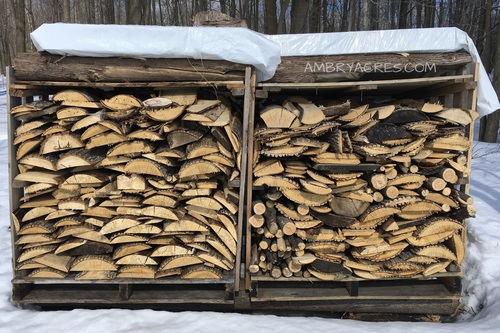
We have learned most of this knowledge through studying The Basics of Making Maple Syrup through Cornell University and have The Sugarmaker’s Companion by Micheal Farrell available to use and refer to continuously. Moreover, it has guided us every step of the way.
MAPLE FACTS
Why does the sap contain sugar?
The leaves absorb energy from the sun and the roots absorb water and minerals from the soil. A simple sugar is produced, which is converted to starch, and is stored within the tree. This is the maple tree’s food and energy reserve. It is also the basis for the sweet sap to be harvested nine months later. Source: massmaple.org
- Sap is the only ingredient. It’s boiled to increase the sugar content from about 2% up to 66%.
- Minimum density of 66% brix and maximum density of 68.9% brix
- It is a requirement that syrup be heated to 180 degrees F or 190 degrees F if packaging in glass
- It takes 40 gallons of sap is needed to produce one gallon of syrup!
- A typical sugaring season lasts 4 to 6 weeks.
- Each tap should make a minimum of 1 litre of maple syrup each season on a gravity system
- A sugar maple that is 10 to 12 inches in diameter is large enough to have one tap; therefore, anything smaller in diameter should not be tapped.
- The sap is mainly water with about 2% sugar, when collected.
How to Use Maple Syrup!
The delicate flavour of maple allows for an array of cooking options. Intrigued and seeking additional inspiration on how to introduce more maple into your everyday cooking then please see our 5 Uses for Maple Syrup post here
Here are a few of our Maple Products
-
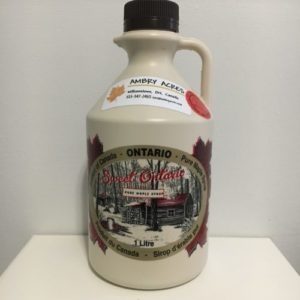 Very Dark | 1 Litre Jug$20.00
Very Dark | 1 Litre Jug$20.00 -
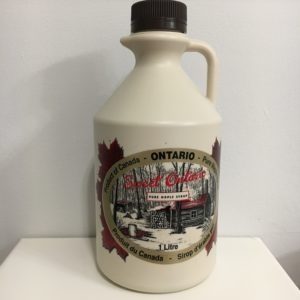 AMBER |1 Litre Jug$20.00
AMBER |1 Litre Jug$20.00

